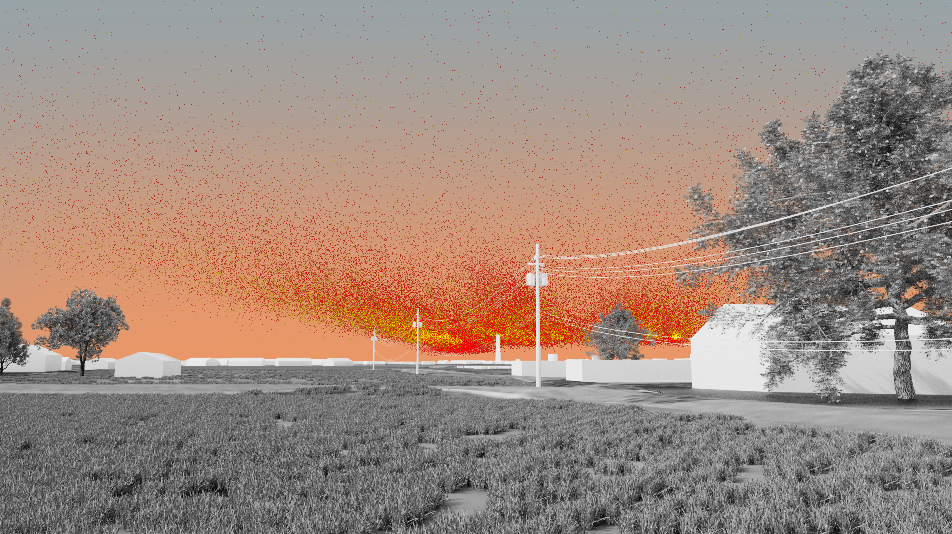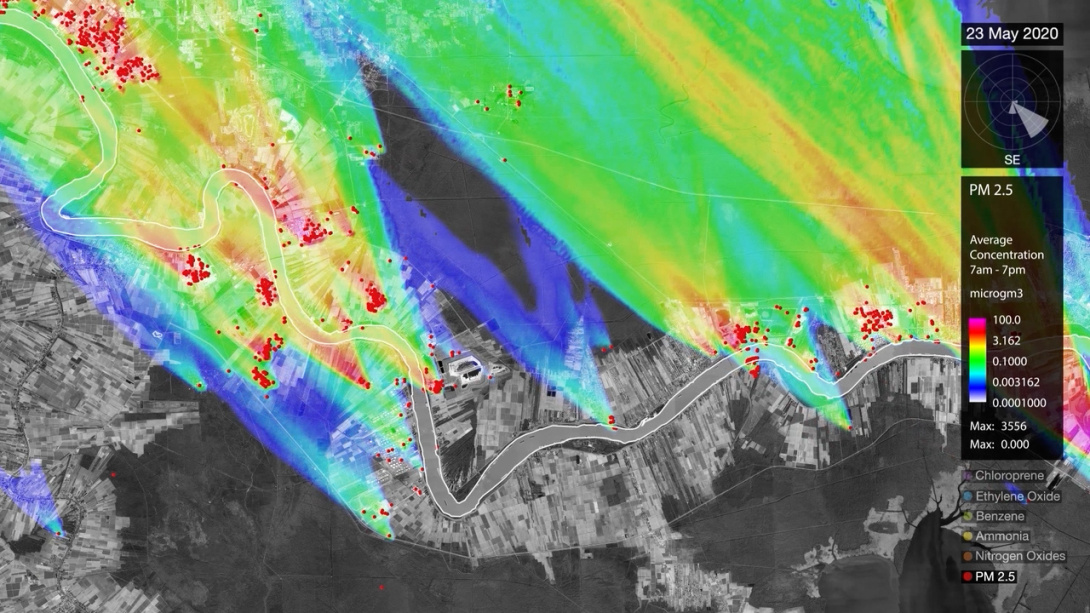A related exhibition by Forensic Architecture will be on view at The Institute of the Arts and Sciences at University of California, Santa Cruz (IAS) as of part the ongoing series Visualizing Abolition.
The San José Museum of Art (SJMA) will present If toxic air is a monument to slavery, how do we take it down? from January 18, 2024 through April 21, 2024. The exhibition will present architectural and environmental analysis by Forensic Architecture to examine degradation and cancer risk as manifestations of colonialism and slavery and offer tools to help combat a three-hundred-year continuum of environmental racism.
In the exhibition at SJMA, Forensic Architecture will present their research on “Death Alley,” Louisiana, a heavily industrialized petrochemical corridor that runs along the Mississippi River between Baton Rouge and New Orleans that overlays what was formerly known as Plantation Country. When slavery was abolished in 1865, more than five hundred sugarcane plantations lined both sides of the lower Mississippi river; today, more than two hundred of those sites are occupied by some of the United States’ most polluting petrochemical facilities. Residents of the majority-Black communities that border those facilities—communities that arose from historical freetowns—breathe toxic air and suffer high rates of cancer. They call their homeland “Death Alley.”
“Forensic Architecture has redefined architecture as an engagement with human rights, and this exhibition demonstrates how they use analytical tools to tell a story,” said S. Sayre Batton, Oshman Executive Director, San José Museum of Art. “They work on behalf of communities affected by police brutality, border regimes, and environmental violence, and develop evidentiary materials that can be deployed in courtrooms and political processes, as well as in galleries, cultural institutions, and through media, in pursuit of accountability for violence committed by states and their agents.”
Forensic Architecture, a research agency based in London, investigates human rights violations. The term “forensic architecture” refers to the production and presentation of architectural evidence—relating to buildings and urban environments—within legal and political processes. To carry out their investigations they use cutting-edge techniques in spatial and architectural analysis, open-source investigation, digital modelling, immersive technologies, as well as documentary research, interviews, and academic collaboration.
A related exhibition on Forensic Architecture will open at the Institute of Arts and Sciences at UC Santa Cruz on January 12, 2024, organized by UCSC professor Gina Dent and IAS director Dr. Rachel Nelson. The exhibitions on Forensic Architecture are part of Visualizing Abolition, an ongoing initiative exploring art, prisons, and justice, with exhibitions collaboratively organized by the IAS at UCSC and SJMA.
SUPPORT
If toxic air is a monument to slavery, how do we take it down? is made possible by the Mellon Foundation and the SJMA Exhibitions Fund, with generous contributions from Mr. Cole Harrell and Dr. Tai-Heng Cheng, and Rita and Kent Norton.
Operations and programs at the San José Museum of Art are made possible by lead support from SJMA’s Board of Trustees, a Cultural Affairs Grant from the City of San José, the Lipman Family Foundation, the Adobe Foundation, the Richard A. Karp Charitable Foundation, Sally Lucas, Yvonne and Mike Nevens, the David and Lucile Packard Foundation, the Skyline Foundation, the Knight Foundation, Brook Hartzell and Tad Freese, the SJMA Director's Council and Council of 100, the San José Museum of Art Endowment Fund established by the Knight Foundation at the Silicon Valley Community Foundation, and the William Randolph Hearst Foundation.
SAN JOSE MUSEUM OF ART
The San José Museum of Art (SJMA) is a modern and contemporary art museum dedicated to inclusivity, new thinking, and visionary ideas. Founded in 1969 by artists and community leaders, its dynamic exhibitions, collection, and programs resonate with defining characteristics of San José and the Silicon Valley—from its rich diversity to its hallmark innovative ethos. The Museum offers lifelong learning for school children and their educators, multigenerational families, creative adults, university students and faculty, and community groups. SJMA is committed to being a borderless museum, essential to creative life throughout the diverse communities of San José and beyond.
SJMA is located at 110 South Market Street in downtown San José, California. The Museum is open Thursday 4–9pm; Friday 11am–9pm; Saturday–Sunday 11am–6pm; and select Monday holidays. Admission is $15 for adults, $12 for seniors, and free to members, college students, youth and children ages 17 and under, and school teachers (with valid ID). Admission is free from 6–9pm on the first Friday of every month. For up-to-date information, call 408.271.6840 or visit SanJoseMuseumofArt.org.

